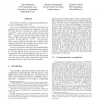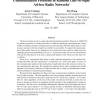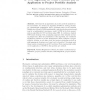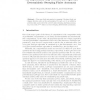SAGA
2007
Springer
13 years 11 months ago
2007
Springer
We present two results for computational models that allow error probabilities close to 1/2. First, most computational complexity classes have an analogous class in communication ...
SAGA
2007
Springer
13 years 11 months ago
2007
Springer
The line-of-sight networks is a network model introduced recently by Frieze et al. (SODA’07). It considers scenarios of wireless networks in which the underlying environment has...
SAGA
2007
Springer
13 years 11 months ago
2007
Springer
In the layered-graph query model of network discovery, a query at a node v of an undirected graph G discovers all edges and non-edges whose endpoints have different distance from ...
SAGA
2007
Springer
13 years 11 months ago
2007
Springer
We consider applications of probabilistic techniques in the framework of algorithmic game theory. We focus on three distinct case studies: (i) The exploitation of the probabilistic...
SAGA
2007
Springer
13 years 11 months ago
2007
Springer
Abstract. Motivated by an application in project portfolio analysis under uncertainty, we develop an algorithm S-VNS for solving stochastic combinatorial optimization (SCO) problem...
SAGA
2007
Springer
13 years 11 months ago
2007
Springer
SAGA
2007
Springer
13 years 11 months ago
2007
Springer
Abstract. Devices connected wirelessly, in various forms including computers, hand-held devices, ad hoc networks, and embedded systems, are expected to become ubiquitous all around...
SAGA
2007
Springer
13 years 11 months ago
2007
Springer
A two-way finite automaton is sweeping if its input head can change direction only on the end-markers. For each n ≥ 2, we exhibit a problem that can be solved by a O(n2 )-state ...




